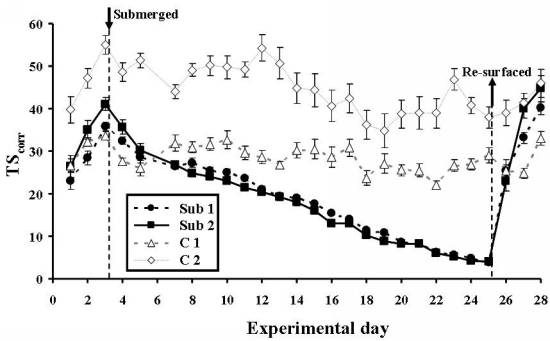|
Subcage biology
Biological tolerances of fish to submerged cage culture
Background Table 1 Causes, depth of influence and duration of unsuitable surface conditions for salmonid aquaculture in sea-cages.
*variable, but usually greatest in surface waters The uncertainty surrounding submergence is related to the assumption that salmon become negatively buoyant when submerged beneath a cage roof as they cannot access the surface to gulp air and fill their open swim bladders. Salmon regulate their buoyancy largely by swallowing air from the surface into the swim bladder which is joined to the stomach and then releasing air when necessary through ‘burping’. Through three successive experiments at the Cage Environment Laboratory of the Institute of Marine Research in southern Norway, the effects of submergence on swimming speeds, schooling, feeding, body and fin condition, and growth rates of salmon in full-scale sea-cages with simultaneous monitoring of environmental conditions were investigated. Methods and Results Figure 1 a) Salmon beneath the roof of a submerged cage, b) Night time view of the sea-cages with underwater lights at 10 m deep.
In both experiments, salmon in submerged cages swam 1.5-1.6 times faster than salmon in surface control cages and schooled more tightly. No evidence of acute buoyancy control problems was observed in the submerged fish and submergence did not affect feed intake. Small reductions in growth were found in the submerged fish in Experiment 1, relative to control fish, however, submerged fish also experienced lower temperatures which likely contributed to this difference. No differences in growth rates were found between submerged and control fish in Experiment 2 when control and submerged fish experienced similar environmental temperatures. While salmon lost air from their swim bladders over time (Figure 2), they appeared to tolerate submergence by swimming faster, possibly as a behavioural adaptation to generate lift to counter negative buoyancy. These results contrast with the strongly negative effects on submergence found by previous trials that used small-scale enclosures in which fish did not have sufficient room to swim freely. Our results open the possibility of shallow submergence of sea-cages for short periods matched to the time scales of negative surface events in search of more favourable conditions at depth. The third experiment assessed the effects of submergence on large salmon subjected to submergence during the dark of winter. On average, 2345 salmon of ~3.5 kg were kept in each of six 2000m3 sea-cages for 6 weeks; three of which were submerged to 10-24 m depth and three acted as surface controls (0-14 m). The submerged salmon seemed unable to refill any gas into the swim bladder, as a linear decrease in echo reflection to <5% of pre-submergence levels after 22 days of submergence indicated loss of almost all gas from the physostomous swim bladders and negatively buoyant fish. Around day 22, submerged salmon swam at night time with a distinct "tail-down, head-up" tilt (26°) compared to the horizontal swimming position of control fish (-3°). Average swimming speeds of submerged salmon were 1.3-1.4 times faster than control fish both during day and night. Almost no mortality was seen, and the submerged salmon maintained similar diurnal vertical migrations as the surface fish, indicating that deep submergence did not exhaust the fish. However, submerged fish fed less efficiently, resulting in lower growth and reduced feed utilization. Fins and snouts of the submerged fish had small, but significantly more erosion than the control fish. Vertebrae in the tail region were significantly compressed in the submerged fish compared to control fish. This could be an early symptom of development of vertebral deformities. Figure 2 Gradual loss of air in the swim bladders of salmon in Experiment 2 following the submergence of sea-cages on day 3 and re-filling of the swim bladders through gulping at the surface when cages were re-surfaced after day 25. TScorr shows the strength of the signal from the echo-sounder, which directly depends on swim bladder size. Sub 1 and Sub 2 show the submerged cages and C1 and C2 the control cages where salmon had access to the surface.
Discussion |
Project leader
Tore Kristiansen (INSTITUTE OF MARINE RESEARCH)
Partners
Institute of marine research Additional collaboration: | ||||||||||||||||||||||||||||||||||||||||||||


